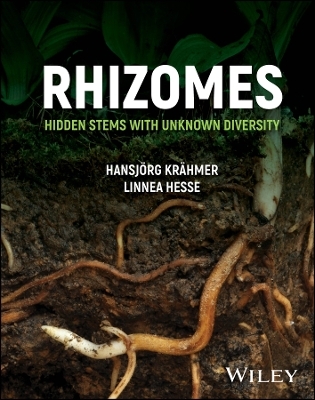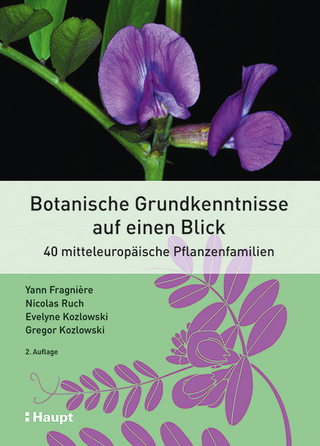
Rhizomes
John Wiley & Sons Inc (Verlag)
978-1-119-82714-6 (ISBN)
Rhizomes describes and compares rhizomes, classifies them based on their features, and presents their ecological and commercial importance.
The book is divided into seven parts. After a short introduction, Part I discusses the evolution of rhizomes and their function as organs. Part II provides an introduction into rhizomes of basal tracheophytes, formerly called pteridophytes, now referred to as Lycopodiopsida and Polypodiopsida or lycophytes and ferns. Part III covers monocot rhizomes with a focus on the high diversity of rhizomes found in monocots. Part IV focuses on dicot rhizomes and their morphological diversity. Part V explores the ecological and commercial importance of rhizomes, with special information on crops and weeds with rhizomes. Lastly, findings on rhizomes in different plant groups are compared, and conclusions on the development and diversification of rhizome characters are presented.
Written by two highly qualified authors with significant research experience in the field, Rhizomes covers topics such as:
Difficulty in making a clear distinction between rhizomes, runners, and stolons and inner cortex cells of rhizomes differing in sheath modifications
Different types of species with stem-borne roots, including dicot representatives with roots arising from the hypocotyl and plants with roots at nodes, internodes, and buds
Molecular genetics research analyzing molecular mechanisms and signaling processes leading to stolon and rhizome initiation and development
Rhizome producing species forming either large colonies or genetically identical groups, with advantages and disadvantages of each
With English literature on rhizomes being relatively sparse, Rhizomes is a unique and highly comprehensive reference on these types of stems, ideal for agronomists, botanists, horticulturists, breeders, ecologists, and weed scientists seeking to understand their important role in agriculture and food.
Hansjörg Krähmer, Past President of the European Weed Research Society and currently based at Bayer AG, Frankfurt, Germany. Dr. Krähmer is a known scientist studying weed plants, crop science, and vegetative anatomy and morphology. Linnea Hesse, Professor, Wood Sciences and Biomimetics, Institute of Wood Science, University of Hamburg, Germany.
Preface ix
Acknowledgements xi
Part I Introduction 1
1 Introduction 3
1.1 The Role of Rhizomes in Agriculture and Pharmacology 3
1.2 Characterization of Rhizomes in Literature 3
1.3 Rhizome Anatomy 4
1.4 Genomics of Rhizomes 6
2 Evolution of Rhizomes and Their Distinction from Similar Plant Organs 11
2.1 Rhizomes of Early Vascular Plants 11
2.2 Rhizomes as Characteristic Attributes of Different Plant Growth Forms 11
2.3 Glossary and Distinction of Rhizomes from Similar Plant Features 12
2.4 Glossary of Terms for Characteristic Rhizome and Stem Features 16
Part II Rhizomes of Lycopodiopsida and Polypodiopsida 19
3 Diversity in Rhizomes of Lycopodiopsida and Polypodiopsida 21
3.1 Lycopodiopsida (Lycophytes) 21
3.2 Polypodiopsida (Ferns) 30
3.3 Summarizing View on Lycophyte and Fern Rhizomes 53
Part III Monocot Rhizomes 57
4 Morphological Diversity in Monocot Rhizomes 59
5 Histological Characterization of Monocot Rhizomes 63
5.1 Anatomy of Monocot Rhizomes – Tissues and Organs 63
5.2 Typology of Monocot Rhizomes 79
5.3 The Stele of Monocot Rhizomes 88
6 Nodes of Monocot Rhizomes 93
7 Monocot Rhizome Development and Tissue-Specific Gene Expression 99
8 Selected, Groupwise Description of Rhizomes 103
8.1 Alismatales103
8.2 Dioscoreales 116
8.3 Liliales 120
8.4 Asparagales 122
8.5 Zingiberales 148
8.6 Poales 160
8.7 Arecales 196
9 Summarizing View on Monocot Rhizomes 203
9.1 Stolons Versus Tubers 206
9.2 Collateral Versus Amphivasal Vascular Bundles 206
9.3 Xylem Lacunas 206
9.4 Borders Between Cortex and Central Vascular Bundle Cylinder 206
9.5 Thickening Meristems 206
9.6 Pseudostems 206
Part IV Eudicot, ANA Grade and Magnoliid Rhizomes 209
10 Morphological Diversity in Eudicot Rhizomes 211
10.1 Stem-borne Rhizomes 211
10.2 Root-borne Rhizomes 211
11 Histological Characterization of Eudicot Rhizomes 217
11.1 Anatomy of Eudicot Tissues and Organs 217
11.2 Typology of Eudicot, ANA Grade and Magnoliid Rhizomes 225
11.3 The Stele of Eudicot, ANA Grade and Magnoliid Rhizomes 227
12 Nodes of Eudicot Rhizomes 229
13 Eudicot, ANA Grade and Magnoliid Rhizome Development and Tissue-Specific Gene Expression 233
13.1 Timing and Location of Rhizome Formation 233
13.2 Molecular Genetics of Rhizome and Rhizome Tuber Formation 246
14 Selected, Groupwise Description of Eudicot Rhizomes 249
14.1 Ranunculales 249
14.2 Proteales 258
14.3 Buxales 260
14.4 Rosales 262
14.5 Oxalidales 266
14.6 Malpighiales 270
14.7 Geraniales 272
14.8 Myrtales 275
14.9 Brassicales 281
14.10 Saxifragales 284
14.11 Caryophyllales 286
14.12 Ericales 293
14.13 Asterales 301
14.14 Apiales 313
14.15 Solanales 316
14.16 Lamiales 320
14.17 Boraginales 329
15 Selected, Groupwise Description of Magnoliid and ANA Grade Rhizomes 333
15.1 Piperales 333
15.2 Nymphaeales 340
16 Summarizing View on Eudicot, ANA Grade and Magnoliid Rhizomes 363
Part V Ecological and Commercial Importance of Rhizomes 367
17 Agricultural Crops with Rhizomes 369
18 Rhizomatous Weeds 373
19 Clone Formation in Rhizomatous Plants 377
Part VI Comparative Synopsis of Rhizome Characteristics 379
20 Differences Between Rhizomes of Different Tracheophyta 381
21 Phylogenetic Relevance of Rhizome Characters 383
21.1 Shoot-Borne Roots as Common Characteristics of Tracheophyte Rhizomes in General 383
21.2 Relationship Between Eudicots and Monocots 383
21.3 Adventitious/Shoot-Borne Roots in Monocots and Eudicots 384
Part VII Final Discussion and Conclusions 393
22 Final Discussion, Conclusions and Outlook 395
22.1 Differences and Common Features of Tracheophyte Rhizomes 395
22.2 Borders Between Rhizome Cortex and Central Bundle Cylinder 395
22.3 Terminology of Functionally Similar Structures in Different Plant Organs 396
22.4 The Development of Rhizomes 399
22.5 What is the Difference Between a Rhizome and a Root? 399
References 399
Index 401
| Erscheinungsdatum | 27.07.2024 |
|---|---|
| Verlagsort | New York |
| Sprache | englisch |
| Maße | 221 x 279 mm |
| Gewicht | 1315 g |
| Themenwelt | Naturwissenschaften ► Biologie ► Botanik |
| Weitere Fachgebiete ► Land- / Forstwirtschaft / Fischerei | |
| ISBN-10 | 1-119-82714-0 / 1119827140 |
| ISBN-13 | 978-1-119-82714-6 / 9781119827146 |
| Zustand | Neuware |
| Informationen gemäß Produktsicherheitsverordnung (GPSR) | |
| Haben Sie eine Frage zum Produkt? |
aus dem Bereich


